Clothes Washing Machines
What the differences between front loading and top loading?
Introduction
There's a lot of nonsense around about the benefits of front loaders
over top loaders and people are being distracted from the purpose of clothes
washing machines. Clean clothes are essential to our well-being and clothes are
clean when they have soil, sweat, bacteria and other grime removed from them. Of course, if your washing machine leaves residues of the laundry detergent or
hard water salts in your clothes, then skin irritation from the chemicals is NOT
what you really expect. Data used to compile this information were correct as at
22nd March 2008.
So how well your washing machine rinses is just as important as how well it washes, perhaps even more so! And if money is important to you, the cost over say 10 years for cost of the machine, cost of detergents, cost of water, cost of electricity and any maintenance should be used in deciding which washing machine type to buy. AND if your machine doesn't need replacing at the moment, don't be conned into buying a new one on spurious environmental grounds. The cost of producing a new one and 'disposing' of the old one may be more environmentally costly than continuing to use what you already have - even if it uses a little more water.
How much sense does the current advertising and government incentives make when choosing a washing machine? Misinformation is being spread about the benefits of front loaders over top loaders and my opinion is that some of the information is a distortion of the real picture and the people who wish to be actively involved in the environment are being deceived. There's also many organisations turning over a lot of money from these deceptions.
Wash
and Rinse Performance - Front Loader vs Top Loader Comparison
Choice (ACA, 2008), in December 2008 reported an update on the
performance of 37 washing machines (18 front-loading and 19 top-loading washing
machines) for wash and rinse efficiency, water use, energy consumption,
gentleness and spin efficiency.
I have taken the information published by Choice (www.choice.com.au December 2008 and extracted some of the data as presented in Table 1 to show that for the three different sizes of washing machines, the average of the wash and rinse performance shows that in most cases there front loaders (light green) perform poorly compared to the top loaders (yellow rows). It is my conclusion that the additional capital cost of the front loader, the increased time of washing against the savings in water use cannot compensate for the higher overall performance in wash and rinse performance of the top loaders. My preference is to choose a top loader, from the top of each capacity listing, as I consider the performance in washing and rinsing clothes the highest priorities for a washing machine. So, a rebate for changing from a top loader to a front loader is an economic disaster in our home. I can save water in other ways to compensate for the greater efficiency and reduce cycle time of a top loader.
From the date presented by Choice, I have deleted some columns and added two others (mauve). The average "calculated on wash and rinse performance only" and the second on the combined cost of the washing machine and its operating cost over ten years in simple terms (no interest or nett present value considerations). The machines are ranked on the averaged wash and rinse performance scores, the best at the top of each capacity, ranked downwards to the poorest performers. My opinion is that these data from Choice are superior to the certification by WELS Scheme, because they give information on which real choices can be made - not just water use. Water efficiency is more important than water conservation.
With the average cost of water at $1.00 per 1000 L there is no incentive to replace a top loader with a front loader on economic grounds.
Table 1. Comparison of wash and rinse for front loaders and top loaders.
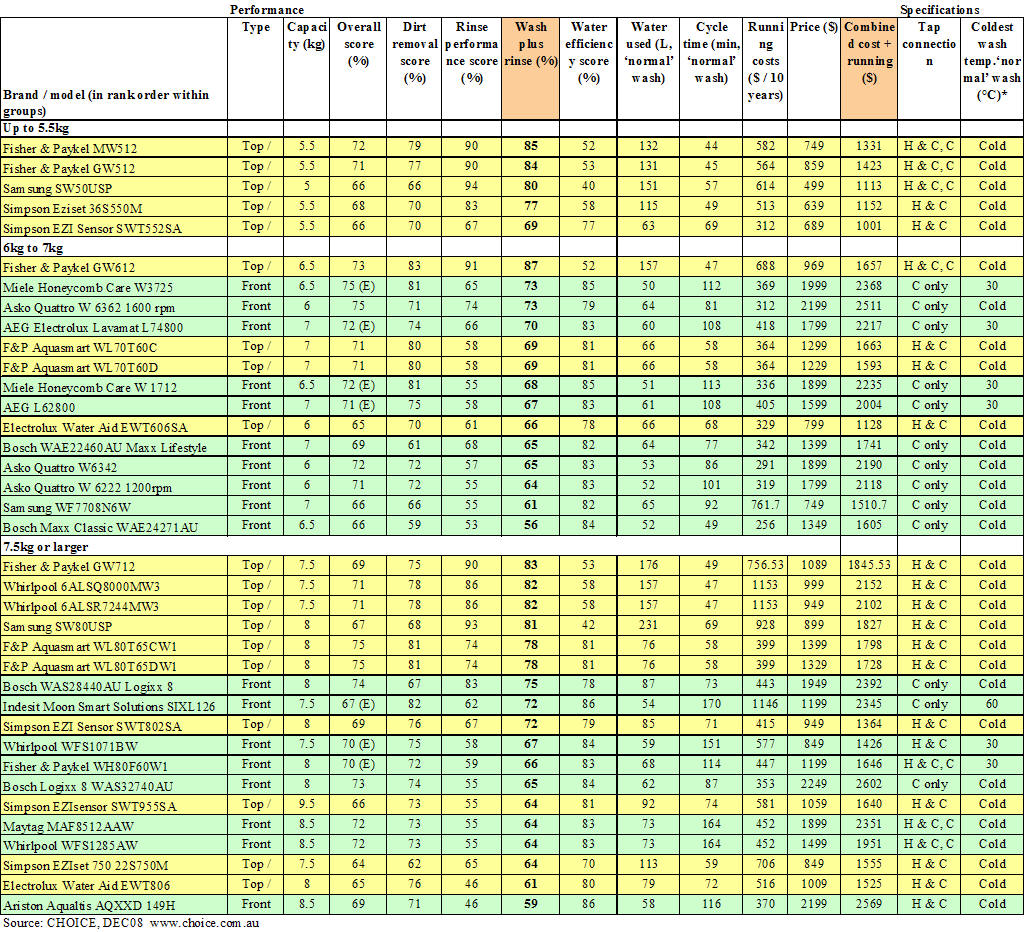
OVERALL COST COMPARISONS
While I have not been able to obtain the price of all the washing machines on
the WELS site (as at November 2007), the prices of 27 front loaders and 21 top loaders were obtained
and a total cost comparison made. The total cost is made up of:
| annual water consumption for washing 36 kg washing per week, for 52 weeks, at a cost of $1.00/kL; | |
| annual energy consumption based upon washing cycle in minutes 36 kg washing per week for 52 weeks, for a 0.3 hp motor, at $0.16/kWh (cold water wash); and | |
| depreciation at 10% of initial purchase cost. |
(Note: I've since been made aware that front loaders do not operate their motors over the full period of whole cycle, rather some time is spent with the clothes soaking. I have not had an opportunity to verify this soaking routine within the cycle.)
It can be seen from figure PC-1 that one could choose a front loader, or top
loader that has a similar annual cost. It is reasonable to assume that
this cost is closer to the environmental cost than simply looking at the savings
of water. Only addressing a savings in water may actually increase the
need for energy.
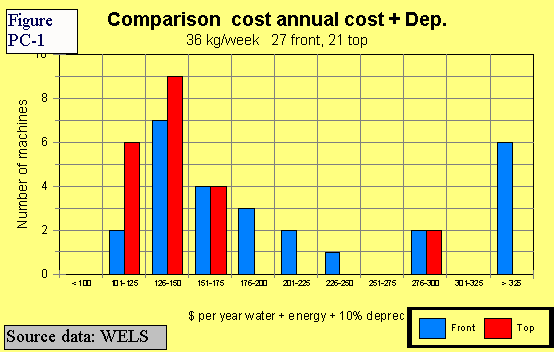 Other considerations could be the cost of detergent but have not
been used here.
Other considerations could be the cost of detergent but have not
been used here.
The individual data for this graph are not reproduced here.
When purchasing your new or replacement washing machine, you should consider not only whether you want to work on your knees or standing up, but:
# how many minutes a complete cycle takes (more time - more energy);
# whether the machine has a cold and hot water connection (otherwise you will be paying for prime energy rates to heat the water, even to warm water;
# whether you can choose liquid or powder detergents; and
# whether you can reduce wash water volume for a small load.
The Australian Bureau of Statistics released 4621.1 -Domestic Water and Energy Use, New South Wales, October 2006 on 10th May 2007. Information from the bulletin are given below:
In October 2006, there were an estimated 2,666,800 NSW households.
An estimated 14% of households had a front loading washing machine (381,900), and 79% (2,103,000) use a top loading washing machine.
Cold water is used for 71% of washing machine loads done by NSW households
An estimated 65% of households do 1 to 5 loads of washing per week, compared to an estimated 12% that wash 9 loads or more per week.http://www.abs.gov.au/Ausstats/abs@.nsf/Latestproducts/4621.1Main%20Features2Oct%202006?opendocument&tabname=
Summary&prodno=4621.1&issue=Oct%202006&num=&view=
WHAT YOU NEED TO KNOW ABOUT THE CURRENT RANGE OF WASHING MACHINES
Here are some details that you may find useful in choosing a washing machine.
1. Don't be conned by government rebates or manufacturers' advertising. There may be plenty of smoke and mirrors!
2. Until the Australia/New Zealand Standard
(AS/NZS 2040.1:2005) was introduced in 2005 there was no standard against which a washing machine
could be rated for RINSE (until July 2006, this Standard was voluntary). There was a standard against which a washing
machine could be rated for washing efficiency and that has been used by
Australian Consumers' Association in their publication "Choice" up
until this new Standard came into being. So when you read
pre-July2006 editions of "Choice" be aware that all recommendations
were made
without knowing how well the machine RINSED the clothes (you won't see any
rating for rinse in their documents).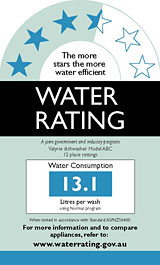 And guesswork does not exchange for actual performance measuring. I believe
that has
finally changed, CHOICE tested laundry powders for rinse quality (Jan
2007) and liquids (2008). I assume they will also test washing machines for efficiency and
not leave it solely to the accreditation process under WELS.
And guesswork does not exchange for actual performance measuring. I believe
that has
finally changed, CHOICE tested laundry powders for rinse quality (Jan
2007) and liquids (2008). I assume they will also test washing machines for efficiency and
not leave it solely to the accreditation process under WELS.
2. The Commonwealth Department of the Environment and Heritage has introduced a mandatory Water Efficient Labelling and Standards (WELS) Scheme (http://www.waterrating.gov.au/about/index.html) that "applies national mandatory water efficiency labelling and minimum performance standards to household water-using products" and replaces the voluntary Water Services Association of Australia's National Water Conservation Rating and Labelling Scheme (ceased 1st July 2006). Each state has also enacted its own legislation to complement the National scheme.
As of 1st July 2006, "washing machines, dishwashers, lavatory equipment, showers, tap equipment and urinal equipment are required to be registered and labelled" (AS/NZS 6400:2005). There are some exemptions until December 2007 that allow the sale of products that were manufactured in Australia or imported into Australia prior to 1 July 2006.
Once a product is registered under the WELS Scheme, compliance with the relevant standard is obligatory (Water Efficiency Labelling and Standards Determination 2005).
The old AAA rating system has gone and equipment displaying that rating scheme was manufactured or imported prior to 1 July 2006.
SO WHAT'S SO SPECIAL ABOUT
WELS and washing machines? (other equipment will not be
considered here)
Other than there is now a rinse performance test required for
all washing machines, I'm yet to be convinced that the scheme is doing anything
other than promoting imported washing machines and forcing consumers into using
machines that may not suit their particular circumstance - a bit like
forcing everyone to buy an imported four-cylinder motor car even if they really
need a truck or a push-bike! (That might be stretching the example a bit, but you may see my
point as you read on further.)
UPDATE:
(31Jan09)
Between December 2007 and January 2009 the listing of washing machines on the
WELS website has changed - and for the worse in my opinion. In December
2007 I downloaded all the information about front loaders and top loaders and
analysed the data for water consumption and rated them with wash time (see
graphs below). NOW - the column for "program time" is mostly blank - YOU
cannot know from the site, so now it's back to the retailers' blurb.
That's not progress. Why remove that information? It is important.
Secondly, the country of manufacture has also been removed, so if you want to "Buy Australian", you cannot find that information from the WELS website. That's insane!
I have also been thwarted by the WELS site, contact with the WELS office, and contact with washing machine manufacturers. Even though testing of the machines to register under WELS scheme requires measurement of each cycle of water use in the whole washing program, no one could tell me what that break-up was. WELS office told me to contact the manufacturers directly. Which I did to no avail. I was interested in the water volume used in the WASH cycle - not available! So where do all the data go? What use are the data if they are not used? Seems there's something wrong with the system.
Compared with the work that Choice reports, the WELS site is not even a second cousin!
The preface to AS/NZS 2040.2:2005 (page 3) states: "The introduction of a rinse performance requirement facilitated the introduction of mandatory water efficiency rating and labelling. Without a rinse performance requirement higher water efficiency rating could be achieved by reducing rinse performance levels that may not meet the needs of washing machine users". Interesting, are they suggesting that not all the previous star rating was all it was cracked up to be?
SO WHAT'S NEW ABOUT AS/NZS 6400:2005 - Water efficient products - Rating and labelling.
Table E1 (page 60 of the Standard) - clothes washing machine water consumption by star rating shows that for an 8 kg washing machine to achieve a four-star rating the maximum water consumption must be 82.3 litres or less (that's 10.3 L/kg). How these values were derived is unclear. What basis they have in terms of being "water efficient" I cannot deduce from the Standard which leads me to assume that they were nothing sort of a "stab in the dark" or a consensus of the people who made up the Standard's committee. Since AS/NZS 6400 was published on 1 June 2005 and AS/NZS 6400 published on 22 Dec 2005, does the water consumption rate bear any relationship to the ability to rinse? Not even five star rated machines were tested for rinse on 1 June 2005.
So you may ask the question - Who benefits from the Standard - the consumer, the manufacturers or no one?
Update: As at 6 January 2007, there were 84 front loaders on the WELS site, of which 74 had a 4-star rating or higher - NONE was made in Australia. There were 66 top loaders on the WELS site and only 1 had a 4-star rating, and that was made in New Zealand.
As of 31 January 2009, there were 221 front loaders on the WELS site that were 4-star or higher. Cannot tell where any of them are manufactured. There were 21 top loaders of 4-star or higher - cannot tell where they are made either. And cannot tell how long the various machines run for a full wash.
GOVERNMENT REBATES - let's look at an example
(there's no special reason I choose a
Queensland example, just that the information about rebates is readily available
from the Queensland Government's website)
"Minister for Natural Resources and Water and Minister Assisting the Premier
in North Queensland
The Honourable Craig Wallace: Wednesday,
August 27, 2008
$277.7 MILLION in HOME WATERWISE REBATES PAID TO QUEENSLANDERS
"The Bligh Government has paid more than $277.7 million in rebates to Queenslanders saving water around their home, Water Minister Craig Wallace said today.
Mr Wallace told State Parliament the government’s Home WaterWise Rebate Scheme had proved tremendously popular with Queenslanders.
“We started the scheme in July 2006 to reward Queenslanders who save water at home by installing rainwater tanks and water efficient appliances,” he said. “To date, the scheme has received over 502,700 applications for more than 562,700 products, and has approved 465,300 applications for a rebate."
Other rebates amounts paid are:
$240.2 million for 239,010 rainwater tanks
$37.6 million for 188,417 four star water-rated washing machine
Source:
http://statements.cabinet.qld.gov.au/MMS/StatementDisplaySingle.aspx?id=59876
Let's look at those figures. To apply for a rebate (cash back) the washing machine has to be 4-star or 5-star rated. Under WELS (as at 31JAN09) there were 221 registered 4-star front loading washing machines and only 21 4-star top loaders to choose from. rated washing machines are imported. Therefore, this cash back given by the Queensland Government is only for imported washing machines. So much for "BUY AUSTRALIAN"! That what I would call hypocritical of a Government that is supposedly for Australian workers!!!!
That means: the Queensland Government's cash back on the 74,842 washing machines totals $15 million (tax payers money).
Research on the "Choice" website showed that the average price of a front loading washing machine was $1500. Certainly there are some cheaper, but many dearer.
That means: the 188,417 individual purchasers will spend collectively $282.6 million less $37.6 million cash back, a total of $245.0 million.
Using the data from WELS (as at January 2009), the average water consumption by 4-star front loaders is 68 litres (range 42-97 L) and for top loaders is 82 litres (range 56/103 L). Assume that a 4-star top loader is a replacement for a 1-3 Star top loader (average water use 121 L), By choosing a 4-star rated front loader over the average top loader, the water savings, on average is 39 litres per wash.
That means: The water likely to be saved for one wash per day every day of the year (365 washes) is 14.2 kilolitres. At a cost of $1.00 per kilolitre the average water saving is $14.20. Over the 188,417 residents, that's a saving of $2.68 million per year. That may seem a reasonable savings for the community but it has cost $282.6 million to get that savings. Some saving!!!!
Taking data on the washing time for front loaders and top loaders (Dec'07), the average front loader takes 131 minutes for a complete wash (range 37-176 minutes per wash) and the average top loader takes 61 (36 to 92 minutes). If the washing machines have the same size motor and all use cold water wash, the energy cost of a front loader over a top loader is an extra 426 hours per year. Assuming a 1/3 HP motor (250 W), the extra energy for the 188,417 machines is $3.2 million.
Put it all together:
Table 2. Comparison of rebates on washing machines with total expenditure and projected savings.
| Description | Money ($AU) |
| Washing machines for which subsidy applied | 188 417 (Govt data) |
| Average cost of 4-star WELS machine | $1500 |
| Total cost of 188 417 machines | $282.6 million (from private funds) |
| Government Subsidy on 188 417 approved washing machines | $37.6 million (public money) |
| Possible savings in water (difference av. front loader to av. top loader) | 39 L per wash |
| Possible annual savings in water for 188 417 machines | 2 675 521 litres |
| Possible annual water savings @ $1.00 per kilolitre | $2.68 million (saving) |
| Possible increase in energy (based upon average wash time) | $3.2 million (increase) |
| SO: to save $2.68 million in water, it cost $3.2m electricity and $283m in washing machines. | |
Some deal! All that has happened is that 188417 FULLY IMPORTED front loading washing machines have been purchased and a water saving has been converted to an increased requirement for energy. Who dreamed up this sort of economics?? What absolute garbage!!! That's environmentally IRRESPONSIBLE!!!!
NEW SOUTH WALES Rebates to Sydney Water customers only apply to 4½ star water efficiency rating of which there are 69 front loaders and ZERO top loaders registered on the WELS site (31Jan09) - http://www.sydneywater.com.au/SavingWater/InYourHome/WashingMachineRebate/
The Rebates provided by Sydney Water can be reviewed in
much the same
way:
(7/12/06) Sydney households receiving
a rebate for purchasing a water
efficient washing machine have reached 20,000 and together they are saving 420
million litres of water a year. Customers can receive a $150 rebate from Sydney
Water for purchasing a 5A water efficiency rating washing machine before 31 July
2008. (source: http://www.deus.nsw.gov.au). By the way, the only machines with a 5A rating were imported or manufactured in
Australia before 1 July 2006. Since 1 July 2006, all imported or locally
made machines have to comply with the WELS scheme and have a star rating (see
WELS label above- correct as at November 2006).
Calculate the savings in water at $1.00/kL, that's a saving of $0.42 million but 20,000 families have paid $30.0 million less $3.0 million of public money towards that small saving. Sure, every little bit help, but at whose cost. By the way, economists would say the payback period was about 75 years - great when the machines will only last 10-15 years!
In neither the Queensland nor the Sydney calculations has the full cost been taken to account for the interest payable on the cost of the machines if the money has to be borrowed, or the loss on investment if the money could have been used for other purposes. The accountants have a neat way to bring future values to today's values. The calculations do not take into account the significant energy required to manufacture, transport and retail those machines, nor the cost of dumping the replaced machines - or the cost of recycling the metals. Nor is the possible rise in water and energy costs included. Pity that Life Cycle Analysis is not applied to the rebate schemes, or even a simple economic assessment. Guess we have to expect that of some of our politicians!
So which type of washing machine should you choose?
There are better ways of saving water using the washing machine
you already have, or using a top loader. The choice of front loader over
top loader cannot be made simply on water efficiency, just the same way you do
not choose a car on ONLY fuel economy. There are some
simple rules for using washing machines wisely such as using full loads only
(although some machines are smart enough to regulate the water to the amount of
washing), reduce the chemical load and reduce rinse cycles to what you find
acceptable. Be aware that by not rinsing adequately, you may end up with
skin irritations that cost more in medical expenses than you saved in water.
Choice (http://www.choice.com.au) makes some good comparisons between front loaders and top loaders. However, if a single rating is used to denote the combined outcomes of energy use, water consumption, rinse quality and maintenance costs, how can you choose a machine that will meet your individual requirements if your prime concern is water consumption. Be a wise shopper! The latest update by Choice is December 2008.
Whether a top loader is harsher on clothes than a front loader may depend upon the detergent used. A powder will generally have a high pH (>10) that can be detrimental to fabrics whereas liquid detergents are more commonly of near neutral pH. What would happen to the ratings on a washing machine if it used a good performing liquid compared with a good performing powder and performed equally on wash, rinse and spin efficiency.
If you are really "feeling good" about buying a machine that is "kind on the environment" (there is not one single washing machine that is "environmentally friendly"), then just buying on water efficiency is really disastrous and you should reconsider your objectives because water use is but one component in a very complex "life cycle analysis" that must be completed before any environmental rating can be made. And if your government is telling you that water efficiency is everything, that's probably because they get the benefits of higher electricity usage, more GST and their political pixie points (sounds cynical....then just think through the advertising).
For a comparison of annual costs of front loaders compared with top loaders, see graph PC-1 at bottom of this page.
COLD, WARM or HOT WATER WASH
Whether you wash in cold, warm or hot water is your choice. Many of the laundry products are made to be effective in cold water and your
experience will best measure the success of your wash and rinse combined. Refer
back to previous page on Laundry to see that some powders failed to completely
dissolve in water. Nearly half of the front
loader washing machines do not have a hot water fitting, hence will not be able
to take advantage of 'off-peak' power rates. In Armidale (NSW) in
September 2006, the difference
is 8.677 cents for off-peak and 16.558 cents for ordinary electricity per kWh. That means that if you cannot connect to the home's off-peak water heating,
energy for heating the water will cost you twice as much as it should. Most of the front loaders on the WELS scheme have been tested at 40 deg C, and
some as high as 60 deg C for cotton materials, so it appears that performance is
based upon warm wash. So is energy use? Many of the top loaders were
tested on cold water, so I can only assume they are effective with cold water. Maybe there's a reason that front loaders are tested on warm water and top
loaders are tested on cold water that we are not being told? Maybe we should ask
more questions! Is this another case of smoke and mirrors?
USING LAUNDRY DETERGENTS
What could be more simple? Laundry detergents need to be mixed
with a small volume of warm water before adding to the water in the washing
machine, unless the machine is equipped with a liquid/powder dispenser. Pouring
detergents directly onto clothes may cause the detergent to lodge in folds in
the clothes and be poorly distributed throughout the wash water, or the harsh
chemicals may directly affect the clothes on which they falls. And don't think
that liquids don't need premixing. Some liquids are nothing more than
suspensions and the container should be shaken before pouring the liquids. Check which brand you have to see if it is clear or a suspension.
Some washing machines only make allowance for automatically adding powder detergents at the correct timing in the wash program. If you want to use liquids because they have very much lower sodium loads, then you may need to rethink the type of washing machine that meets your requirements.
WASHING MACHINE BY TYPE
The raw data for the following graphs have been sourced from the WELS
website (http://www.waterrating.gov.au/about/index.html)
and analysed by Lanfax Labs (correct as at October 2006). The energy comparison is made simply by calculating
the cycle time (in minutes) for a normal wash as provided by WELS. The energy
will include heating water that has not been accounted for in this comparison.
Remember, you are buying this washing machine for your benefit (to wash, rinse then spin your clothes), not for some 'good feeling' about the environment unless you are able to account for all the inputs into environmental benefits (which I doubt any of us can do!). No washing machine can be environmentally friendly, some may be more environmentally sensitive, but simply the acts of using detergents, energy, treated water and the resources that were used to make the machine have created their own suite of environmental impacts.
NOTE: From the current WELS site (31Jan2009) it is NOT possible to reconstruct the following graphs - most references to program time are blank.
Front loaders
The comparison between front loaders is made on the basis of 36 kg of
dirty clothes each week. Small machines have to do more loads than large
machines. Each graph has been divided into washer sizes, from left 5.0 to
5.5 kg, 6 to 6.5 kg, 7.0 to 7.5 kg and 8.0 to the largest at 10 kg.
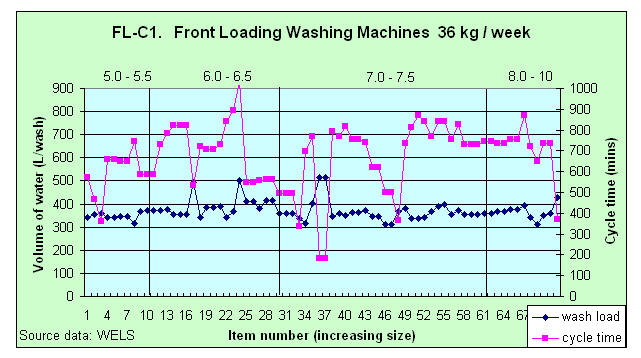
FL-C1 shows that the washing times (red line, right hand scale) are highly variable for washing 36 kg per week while the water consumption is reasonably constant between 300 and 400 L per week.
It is therefore possible to choose a front loader that is reasonably energy efficient - low cycle times, provided you don't count energy to heat the water.
The graph shows that there are not necessarily economies of scale in relation to water use or cycle time.
It is not possible to identify machine makes and models from the graph. The reader can make these same decisions by referring to the WELS website. Please do not contact Lanfax Labs as we will not identify the makes and models for you.
When using front loading washing machines, it is important that full loads are run. When choosing a washing machine, check whether you can choose varying water levels for different type and size loads.
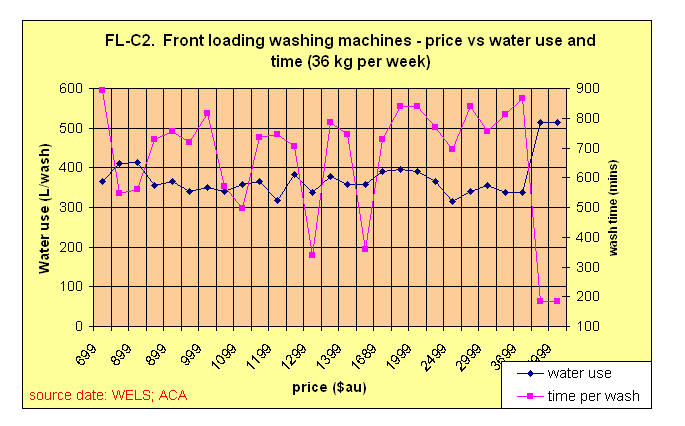
Graph FL-C2 is a comparison of cost (x axis) to the washing time (red line, right hand axis) and water consumption (blue line, left hand axis). Price data were taken from Choice (ACA, June 2006) and the water and time from WELS website (Nov 06).
It is possible to choose front loading washing machines that use small volumes of water (low blue line) and use low energy (red line, low cycle time).
And spending more money does not necessarily mean lower wash times or smaller water volumes. However, it may mean more choice of washing/rinse cycles and how you handle sensitive fabrics, or spin difficult clothes.
Top Loaders
The comparison between top loaders is made on the basis of 36 kg of
dirty clothes each week. Small machines have to do more loads than large
machines. If you have a large family or heaps of washing, then you need to
choose larger washing machines to save energy. Each graph has been divided into washer sizes, from left 4.5 to
5.5 kg, 6 to 6.5 kg, 7.0 to 7.5 kg and 8.0 to the largest at 9.5 kg.
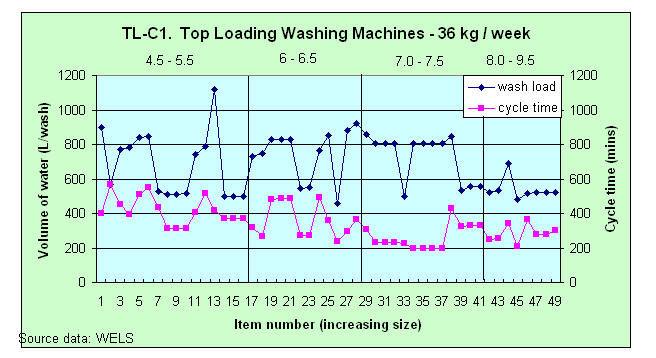
It is clear from TL-C1 that there are small machines that use more water than larger machines (blue line) and it is also possible to choose machines that uses both low water and low energy (both blue and red are at low levels). Energy is equated to washing time since it has been impossible to identify the wattage of motors used in the machines, even by examining actual motors on washing machines at a local repair centre.
The graph also shows that there are economies of scale for the 36 kg wash, the larger machines using less water and less energy. In theory, this would also lead to less detergent use.
For small families, it is not possible to compare water and time from the graph, as it related specifically for a family of four.
In every case, it is important that the machines are run only
when full, unless the machine has a variable volume control. And many machines
while they may have variable wash volumes, they use the same volume of water for
rinsing irrespective of wash volume.
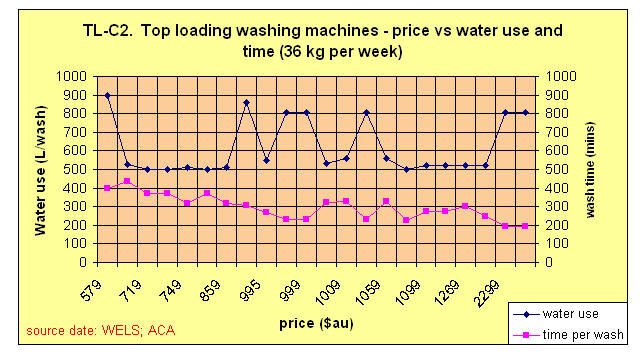
Using data from Choice (ACA, 2006) the price of some machines could be found (as at June 2006) and these were matched against the volume of water used to wash 36 kg (a family of four). The graph TL-C2 shows the wash time (red, use right hand side scale), water consumption (blue, use left hand side scale) and the price of the washing machine (use X axis).
There are machines that will use low energy, low water and can be bought for less than $1000.
From TL-C1 and TL-C2 it is not possible to identify the machine make or model. You will need to visit the WELS site to find that data. Please do not contact Lanfax Labs as we will not identify the makes and models for you.
These graphs are design to show that choices can be made that suit our individual needs.
The data used to prepare these graphs were accessed from the WELS website in August 2006 and checked again in November 2006. An update on the star-ratings was made on 6 January 2007.
TOO MANY UNANSWERED QUESTIONS
I have many unanswered questions that have arisen during the
preparation of the information above.
The first one "Who profits from the misinformation?" is the most difficult to answer because from politicians to water and energy authorities, to importers and local white goods retailers, to those involved in so called 'standards' preparation, to regulatory and testing authorities, it seems that benefits accrue all along the way. The real losers are the individuals who have to pay on the belief that it is all good for the environment. I can save more water with my current top loading washing machine by using only full loads and by reducing the amount of clothes washing that is required. That's sometimes difficult where young kids are involved. But I can reduce the wastewater salinity by selecting appropriate detergents.
What are the hidden costs of water reduction? If the front loaders do not rinse as well at top loaders (see the data re-analysed from Choice data in Table 2), then the additional cost of itchy skin, skin rash, deteriorating clothes and highly saline wastewater are real NEGATIVES that are not being divulged to those who have a right to know.
Why is the advertising required for washing machines and washing products so pathetic? Why are there not the same requirement for "truth in labelling" that applies to other products? The only answer that keeps coming to mind is that there are very many vested interests in keeping that information from the public.
If you believe the advertising is okay, then why is powder laundry detergent sold by the kilogram and consumed by volume. That is such stupidity I cannot understand why the government fair trading departments are not onto it like a tonne of bricks. If you and I were to conspire such advertising the agencies would not be so lenient! I'm disgusted!
Rinse efficiency. What I don't understand is how 4-star front loading washing machines can use an average of 9.5 L/kg (7.2 to 10.3 L/kg) to wash and rinse clothes, while the 3-star top loaders use 13.7 L/kg average (12.5 to 13.7 L/kg). Why is such as small difference such a catastrophe? From where did Standards Australia derive their requirements for efficient machines? Did it have anything to do with wash and rinse efficiency? Or were the numbers derived by "consensus" among the committee? So will Standards Australia revise the Standard in line with the results of testing with 'real' detergents? Don't hold your breath!